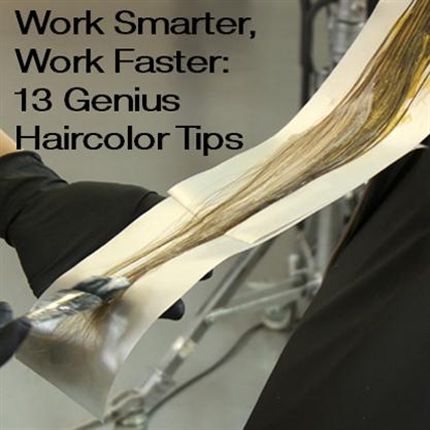Work Smarter, Work Faster: 13 Genius Haircolor Tips

By Jackie Summers
From product selection to timing to test stranding, it’s the little things that add up to stellar color service. Here are 13 insights—all tried and true—into the craft of haircolor that will help you stand out from the crowd.
1. Demis vs. Permanent Color
Nowadays there are many great choices within the demi-permanent category—some are acidic/deposit-only formulas while others are slightly alkaline and provide a moderate amount of lift, and therefore, grey coverage. Demis are always kinder to the hair than permanent color, so whenever possible, consider using them on your clients, says Redken Haircolor Consultant David Stanko. “Particularly if you’re doing a tone-on-tone color, like a Level 5 formula on Level 5 hair, you can color, cover and blend hair that is between 50 to 75% grey with minimal demarcation,” he says. “You don’t get perfect, 100% grey coverage all the time with demis, but many women don’t want permanent color on their heads. So if she’s ok with coverage that’s a little less than perfect, go with demi.” Also, demis are the ideal solution for tonal shifts that don’t require lift. For example, consider a mature client whose hue has become drab and dull with time. A demi-permanent glaze with a ginger or gold formula, says David, will warm up her tone without altering her natural level.
Don’t Beat the Clock
Everybody is always anxious to process clients as quickly as possible—after all time is money! Bad idea, says Matrix Artistic Director Patrick McIvor. Reducing the recommended processing time leads to all sorts of problems, like premature color fading and reduced vibrancy. “It’s true with all shades, but especially reds,” he says. “So always process your color formulas for the maximum amount of time recommended by the manufacturer.” Agrees David, “These products don’t have a brain. They don’t know if they’re going on fine, medium or coarse hair. They don’t understand that the client is running late. If you want your reputation to be stellar, stick to the rules. It will ensure that your results are predictable and consistent.”
Foil By Hand
When foiling, the color pros at the UK’s HOB Salons use a hand + comb technique, which Senior Color Director Christy Blake believes is the best way to get the foil as close to the root as possible. So create the desired weave or slice with your tail comb, snug the foil up to the scalp with your hand instead of the comb, and then use your comb to fold the foil.
Peanut Butter or Honey?
No, those aren’t your lunch choices. They represent the range of consistencies of various manufacturers’ color and, says David, it’s important to master the consistency of your salon’s brand! “Know your color line,” he declares. “If you’re working with honey, it spreads as soon as it comes in contact with a warm scalp. Peanut butter, on the other hand, stays put and that makes it easier to miss spots on the head. So check your application carefully. If you discover a spot that you’ve missed, don’t add more color—simply move a bit of the color that you’ve already applied onto the bare spot.”
Last Minute Highlights
Often, a single process client makes a snap decision to add highlights to her color service while she’s sitting in your chair, and you don’t have time to retouch, rinse and highlight. When that happens, Davines Artistic Team Member Naomi Knights combines the services. “For example, if it’s a grey coverage brunette client who comes in every four to six weeks,” she says, “I’ll apply her regrowth color and then use a paste bleach that contains a dedicated brown toner and apply the highlights. The bleach lifts quickly and both formulas are ready at the same time.” Most of the time, she adds, the color meets her client’s expectations and moving forward, she will be a double process on Naomi’s books. “Then next time,” she adds, “I’m able to book her properly.”
Glaze for Glory
Perform your glazes thoroughly and properly, warns David, or you’ll see your revenues drop. For example, if you cut the processing time, your glaze won’t last and the next time she comes in your client might very well say, “Let’s skip the glaze today,” because she doesn’t see the value in the service. “If you start losing those $25 glazes, it can really add up,” David points out. “So follow the manufacturer’s instructions carefully. Power or towel dry the hair, comb it out, apply the glaze first at the scalp, then on the midlengths and then, if necessary, dilute it and pull it through to the ends because the ends need love, care, condition, shine and tone–but not as much processing time as fresh root color. Then process at room temperature for the full 20 minutes, or whatever the manufacturer recommends!”
End Games
For a lively, natural, sun-kissed look, Naomi has devised a unique combination of foil highlights and hand-painted balayage. “Apply your foils,” she explains, “and then hand-paint some of the ends that are left out, primarily around the face. If you’re using multiple highlight shades, place the lightest color—probably bleach with a low volume of developer—on the ends. I work with a Davines bleach,” she adds, “that allows you to add conditioning toners, so as it lifts, it also tones.”
Damage Control: Bleach Vs. High Lift Blonde Color
A large portion of the color appointments on your books are for highlighting, and for each highlighting client, it’s important to be judicious about your choice of lightener—i.e.: bleach or high lift? “Your choice is based on two factors,” says David, “natural level and texture.” For most manufacturers, the cut off for high lift formulas is Level 5—anything darker and you’ll need bleach to avoid brass. When it comes to texture, it’s important to understand the characteristics of fine and coarse hair. “Once the cuticle layer—anywhere from five to seven layers—is swollen,” explains David, “color acceptance depends on how much of the internal ‘guts’ or cortex remains. Fine hair doesn’t have much of a cortex so it accepts color quickly. It’s also delicate. Coarse hair has a fatter cortex and requires more saturation. So generally, bleach lighteners are preferred for coarse textures—they produce a blonde result without too much warmth. For fine textures, you can minimize damage with a high lift formula.”
Test Strand Strategies
Colorists know how important test stranding is, but the time required to process the strand often deters them. “I think test stranding is underused in salons,” declares David. The practice can be done for two purposes, he explains: fashion or function. For example, if you’re performing corrective color or a dramatic color change, it’s the best way to head off a problem by ascertaining product performance and processing time. If you’re contemplating a shift in your client’s look, it’s the perfect way to show her exactly what you have in mind. “The easiest way to test strand is to apply your client’s retouch, then take the test strand at the occipital,” David advises. “Check it every few minutes and if you have to, wipe it off with a towel. Then you can show her and say, ‘This is what I’m thinking of trying on you—what do you think?’” Patrick also believes that test strands can be the colorist’s best friend. “If you do a test strand, you will discover a lot of cool things and it will help you predict what will happen and discover new opportunities,” he says. “If you’re doing foils, go ahead and do a test strand between the foils. Set the timer for 10 minutes and by the time you finish placing the foils, your test strand will be ready.”
The Non-Negotiable Patch Test
At HOB salons, new clients are encouraged to come in for strand tests, but when it comes to skin or patch tests, there are no options. “Any new client, or any client we haven’t seen for three months has to come in for a skin test,” Christy explains. “We are quite tight on that—it’s salon policy. We keep record cards and track it carefully.” This is the perfect time to do a strand test as well, she notes, but most important, it protects clients, and the salon, from problems stemming from unexpected, adverse client reactions.
Optical Hairline Illusion
Ever notice that hairline section, right in front of the ear, that seems to literally drink up tint? “That area often seems to absorb more color,” comments Naomi, “and as a result, the color tends to appear darker and inkier.” The solution, she says, is to create a hairline formula that is one-half to one full shade lighter than the color on the rest of the head. “Clients don’t like darkness around their faces,” Naomi says, “and this solves the problem beautifully!”
Color Top Up
When clients pop in for a blow dry between color services, Christy and her HOB colleagues offer a quick color top-up to keep hues fresh. “We like to apply a pure tone color gloss after every one-to-three shampoos,” she explains. “It’s like a top coat for haircolor.” The gloss goes on quickly with a bottle applicator and clients are thrilled that their color remains first-day fresh throughout the color cycle.
Take Your Time
Today’s clients are busy, busy, busy—and that’s the best reason to slow down, says Patrick. “Most women have jobs and kids and the truth is that there are only two places where nobody bothers them—the bathroom and the salon!” he says. “So it’s possible that they don’t mind spending a little extra time in your chair. Take advantage of that fact to make each client’s experience as special as possible. At the very least, give her an extra 10 minutes to read a magazine or just chill out—it’s probably the only peace and quiet she’ll have until her next appointment!




